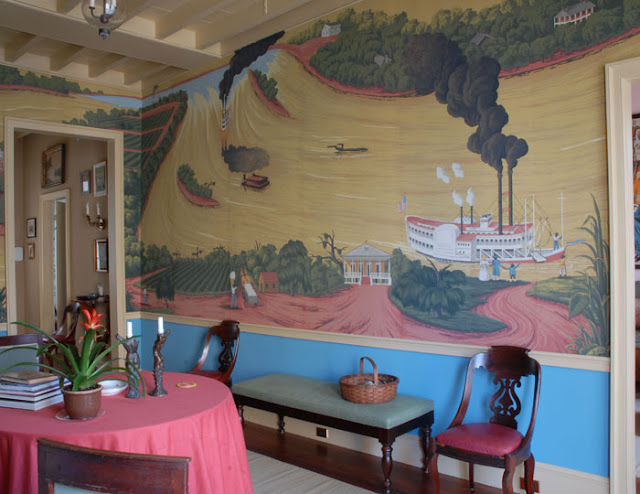Pierre Finkelstein is the owner of Grand Illusion Decorative Painting, in New York City. His client list includes many of Forbe's wealthiest from around the world, the very best interior designers, celebrity clients from Bon Jovi to Bill Gates, and venerable institutions such as the Getty Museum in L.A. and the Frick Museum in New York.
Firstly, I'd like to thank Pierre for letting us into his private atelier to view what is clearly a lifetime's worth of incredible reference books, and that's not to mention the filing cabinets full of catalogued photographs from all over the World, and what must be a vast digital library too. This is a man who understands that no matter how good you are, you're never too good to learn from the past.
Author, painter, teacher, bookseller, even manufacturer of his own line of brushes and tools, Pierre's been at the top of his game professionally for years, so it's not surprising that his shelves are overstuffed with obscure reference manuals and folios of vintage prints. These are the shelves of someone who clearly uses books.
Of his collecting and his "thirst for reference," Pierre admits that he is "a book and brush fiend:"
"What can I say?" he adds, "I especially cherish the folios i have acquired over the years, and my rare out of print editions of paint and decorative manuals. I have paid as much as $600 for an out of print Italian book on ceiling painting ( took me 10 years to find it) and $250 for a 10 page folio.. no matter the price, if one plate (page of a folio) or one page will give me the idea that I need to realize a several thousand dollar project, it is a well worth investment."
I won't list every title, because I couldn't possibly, but here are a few highlights. Starting from the top, a Strand bag gives a clue to the possible source of some of Pierre's purchases. Boasting "eight miles" of shelves, with most of them seemingly dedicated to art books, Strand is a must-see for any New York tourist.
Next shelf down, we start with Gamle Trehus, literally "old wooden house;" a book about architectural details in Norwegian folk buildings. Continuing with the North European theme, Brockdorf's Palace, otherwise known as Frederik VIII's Palace, in Copenahgen is the subject of this book dealing with the restoration in 2009. Neo-Classicism in the North is a book I highly recommend for those interested in Swedish interiors, and that particularly Scandinavian color sense and formality with regard to decorative painting.
Nicolas Petit and Jean-Francois Hache get the monograph treatment for their outstanding marquetry. Williamsburg: decorating with style is more a reference book on period details than it is about painted interiors per se, and is more general in theme than the highly recommended Paint in America volume by Roger Moss, which gets into fascinating detail about historic colors of america. It's a much dog-eared and underlined book on my own shelf. Architect Russell Versaci's popular book on how to convincingly create that New Old House look, from an American perspective yet using classical ideas of proportion. Paris Rome Athens is dedicated to the Grand Tours of some of France's best known architects of the Eighteenth and Nineteenth centuries, featuring many of their stunning ink-wash renderings of antiquities.
Moving to the right I can just about make out a few classic instruction books such as Spencer's The Art of Woodgraining, The Art of Marbling, and Parry's Graining and Marbling. All worthy tomes. Borghini's Marmi Antichi is a hefty reference manual identifying literally hundreds of marbles, as is Hoepli's Pietre Decorative. Faustino Corsi's original 1833 version of Delle Pietre Antichi is available for free PDF download, but of course the FMR version is much sexier.
I'm a sucker for books on French wallpaper, so I spotted Joanna Banham's Papiers Peints right away, along with Papiers Peints Francais (Rizzoli, French version), and Les Papiers Peints En Arabesques. Textile designer Fortuny sits next to stencil books by Althea Wilson and A. Desaint . The justly ubiquitous Dover publications are next, along with a couple of Pepin press classic reference books. Pepin's print quality has always trumped Dover's, in my opinion, although Dover is just so damn cheap and they cover so much ground that they're unbeatable.
Large format Konemann volumes on Italian Palaces, and smaller books on Italian frescos are hidden behind a loose stack of books.
Thomas Jayne's The Finest Rooms in America
Masseuci's book on Antonio Bassoli
Antonio Bassoli; decori e Arredi
Les Boiseries du Musée Carnavalet
Now Playing: Hand-Painted Poster Art from 1910-1950
Identifying Marble, Jacques Dubarry Lassale, published by H. Vial
Venetian Palazzi, published by Evergreen
Felice Giani, two volume set by Anna Ottani Cavina
Barberot's rare Traité Pratique series is here represented by his book on cabinetmaking (or Menuiserie), published by C. Béranger in 1911. I couldn't find that one for sale, so nice score, Pierre!
Okay, well that should keep you all busy for a while. And I didn't even get to the bottom shelf (below), or any of the Henri Vial editions that Pierre offers on his website.

 |
| You'll just have to hit the reference library for copies of these superb vintage titles, I'm afraid |
 |
| These last three images are of some of the many excellent titles that Pierre offers for sale at his site |
 |
| A parting shot of another set of Pierre's personal collection. You'll just have to do your own digging for these titles! |
























































